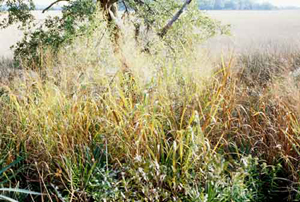Switchgrass (Panicum virgatum)
Switchgrass is a native, warm-season perennial grass. Switchgrass grows best on well-drained soils with good moisture supply; however, it will grow on droughty or moderately wet soils and will tolerate occasional flooding. Once established and properly managed, switchgrass is a long-term perennial. In areas like Raleigh, N.C., it can last up to 15 years. But carrying, or stocking, capacity is not as high as that of hybrid bermudagrass. Yields range from 3 to 5 tons per acre. Switchgrass is an erect, bunch-type grass with medium to large stems and short rhizomes. Under grazing, leafy regrowth develops from basal and axillary tillers. Plants are ready for grazing several weeks earlier than Coastal bermuda. Peak production months are May to July. Cultivars vary widely in heading dates, ranging from June to early August. This plant has weak seedling vigor. When continuously grazed to a 6-inch stubble, switchgrass is a very high-quality grass — 70-percent to 78-percent digestible and 10-percent to 15-percent crude protein. It is very palatable and intake is high. Switchgrass is not recommended for young, growing stock because crude protein is usually not high enough for adequate growth. In addition, severe cases of photosensitization have been observed under wet and humid conditions with litter from previous hay crop on the ground.
Luginbuhl, J-M. 2006. Pastures for Meat Goats. In: Meat Goat Production Handbook, ed. T.A. Gipson, R.C. Merkel, K. Williams, and T. Sahlu, Langston University, ISBN 1-880667-04-5.


